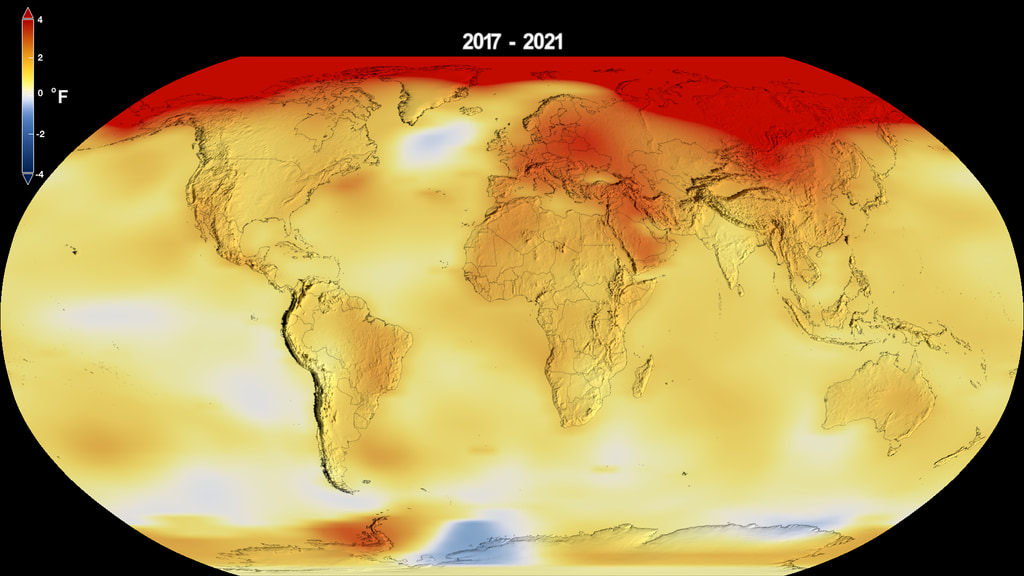Here's a quick summary of what climate change is and isn't, and why it matters for you.
What is climate change?
Climate describes the weather patterns experienced in a location across the year. The UK for example has a temperate, wet and maritime climate. We have frequent cloudy conditions, cool average temperatures, and infrequent temperature extremes.
Manmade global heating has changed the climate around the world. Burning fossil fuels such as coal, oil and natural gas, we release carbon dioxide (CO2). This pollution remains in the atmosphere for hundreds of years, and traps heat from the sun near to the earth’s surface. Increased CO2 has increased the average temperature on Earth by 1.3° since 1880. Whilst this average change sounds small, some areas have been more affected than others.

Map that shows average global heating currently seen across the world.
However, temperature shifts are not the same everywhere. Some areas, like the arctic and Antarctic have warmed much more rapidly than the rest of the world. For example, in March 2022, temperatures were 40° above average in Antarctica. Closer to home, in July 2022, temperatures exceeding 40° were experienced in the UK for the first time in all of human history. The average annual temperature may only have increased by 1.3°, but extreme temperature spikes have become much more common.
Why is climate change dangerous?
By 2050, in the most likely climate scenarios, we will see average summer temperatures that are 2° hotter than in 1990, and winter temperatures that are 1.5° hotter. However, this does not mean that every day will be 1.5° or 2° hotter. This average change masks the extreme weather events caused by climate change. Exteme weather (including summers like those currently being experienced across the Mediterranean, Canada and China) can drive major catastrophes, such as large forest fires.
Similarly, rainfall in the summer will be down an average of 20% from 1990 levels, and winter rainfall will increase by 10%. Again though, this isn’t the whole story. Rainfall will likely be much more intense when it does occur though, meaning that more water is hitting the ground at any given time. The extended dry spells between rainstorms will mean that the ground is drier too, meaning less water is absorbed by the ground. This will likely result in more surface water flooding, as we saw in the UK this year where a hot and dry June gave way to an unseasonably wet July. For more examples of the range of extreme weather events caused by global heating, you can see the map linked below.
https://www.carbonbrief.org/mapped-how-climate-change-affects-extreme-weather-around-the-world/
Extreme Weather Round the World
Extreme weather events can greatly impact our economy, our food supply, and our daily lives. For example in 2022, Pakistan was devastated by floods. These had an economic impact north of $2bn and increased local food costs by up to 500%.
The same extremely unusual weather patterns that caused these floods, also caused an extreme drought in China. The Yangtze River Basin, a major agricultural region and population centre, saw over 4 million hectares of agricultural land in drought causing large crop losses. 80% of the energy supply in the area also comes from hydroelectric dams. As the drought continued, the Yangtze river dried up - causing major drops in productivity for the regions industry and factories. The cumulative effects of climate change can be devastating, and these impacts are likely to accelerate as average temperatures increase. These major hazards are happening at 1.3 degrees of warming. For an idea of the likely temperature increases we will see over the next eighty years, see the image below:

The above figure from the IPCC shows the possible average temperature rises likely to be seen by different generations.
Wildlife
This warming world doesn’t just affect humans, but also harms animal and plant life across the planet. Between 1970 and 2018, the number of animals on earth shrank by 69%. Biodiversity, a measure of how many different species occupy an ecosystem, has also declined rapidly over the last 50 years. In the worst affected areas like South America, there has been a 94% reduction in biodiversity since 1970. According to the UN, 1 million animal and plant species are now at risk of extinction.
This is driven by human activity and climate change, which has altered the habitats these species live in, creating conditions unsuitable for them to survive. For example, pollinators like bees have declined rapidly in recent years, with up to 24% of europe’s bee species threatened with extinction. 75% of global food crops rely on bees for pollination.
We should do all we can to prevent the damage caused by climate change. This June was the hottest June in at least 120,000 years – nearly the entire span of human existence on Earth. As the UN (United Nations) Secretary General said on July 27th, the era of global warming has ended. “The era of global boiling has arrived.” If we are to act to limit emissions and prevent the worst effects of climate change, the moment is now.
